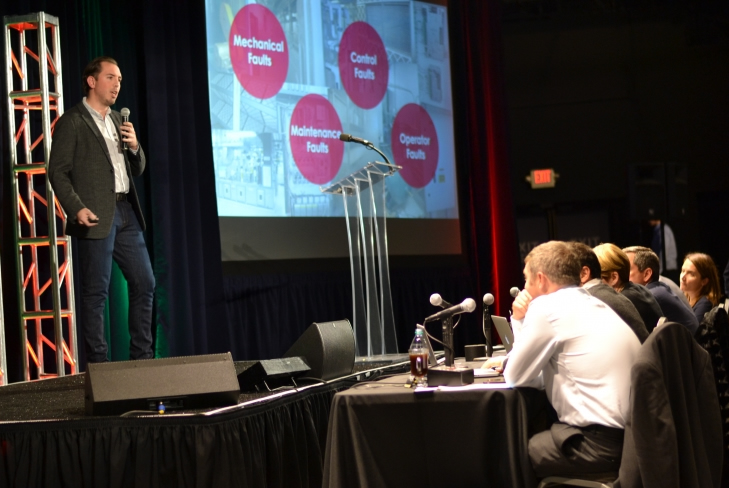
Architectural engineering doctoral student Adam Regnier (pictured right) and his startup company Kinetic Buildings, was a recent winner of the Catalyst Energy Innovation Demo Day on December 10th, sponsored by the U.S. Department of Energy’s (DOE) Building Technologies Office (BTO) and held at the Franklin Institute in Philadelphia. This Demo Day is part of the DOE’s four stage Catalyst Energy Innovation Prize Program “designed to accelerate ubiquitous, affordable solar energy and energy-efficient building technology deployment by connecting American innovators to the tools, capabilities, data sets, and resources developed by the Energy Department and its national laboratories. The competition leverages each of these assets to boost cutting-edge clean tech companies and tackle time-sensitive market challenges.”
The four stages of this prize program are: 1) Ideation; 2) Business Innovation; 3) Prototyping; and 4) Incubation. The Business Innovation stage narrowed the initial nineteen startup companies down to seven and was designed to help these participants create business solutions to the most compelling problems identified during the Ideation stage. Participants were required to submit a business plan and a five minute video describing the business plan. The seven selected startups from the Business Innovation stage then presented their prototypes to a diverse panel of judges and a large audience of innovators, entrepreneurs, investors, and researchers during the recent Demo Day.
Kinetic Buildings was founded by Regnier in 2015 and was one of these seven finalists at Demo Day. Kinetic Buildings is developing low-cost automated diagnostic software solutions for commercial buildings. Commercial buildings represent almost one fifth of all energy consumption in the United States. HVAC consumption in these buildings consists of 43% to 55% of total energy used. Fifteen percent to 30% of HVAC energy is wasted due to faulty operation. Faulty operation can be the cause of mechanical, maintenance, operator, or control faults. Overall benefits to identifying and fixing these faults are improved comfort, energy savings, service scheduling, life of the equipment, and air quality.
Fault diagnostic tools have not been widely adapted by the commercial building industry due to the current lack of low-cost and accurate solutions. Regnier has spent his last four years at Drexel developing technology for detecting and diagnosing HVAC system faults using a holistic approach to generate automated diagnostics that can easily be conveyed to and interpreted by a building operator using a probabilistic output. This system-wide data driven analysis can minimize manual labor requirements and reduce operating costs.
The fundamental research for this software was conducted at Drexel University in conjunction with Regnier’s advisor, Associate Professor Jin Wen, PhD and Drexel's Building Science & Engineering Group, and was supported by the Department of Energy's Consortium for Building Energy Innovation (CBEI). Regnier will use this DOE assistance to transform these efforts from research-grade to a commercially viable product, which includes the development of a front-end user interface.
Each of the winning teams at Demo Day received $30,000 to continue the refinement and development of their product. Over the next six months, the winners must meet specific progress milestones with the goal of introducing their products into the commercial marketplace. After the successful completion of these milestones, each team will receive an additional $70,000, making the total awarded prize $100,000. More information about initiatives sponsored by the Department of Energy’s Building Technology Office can be found on their website.
Image credit: U.S. Department of Energy